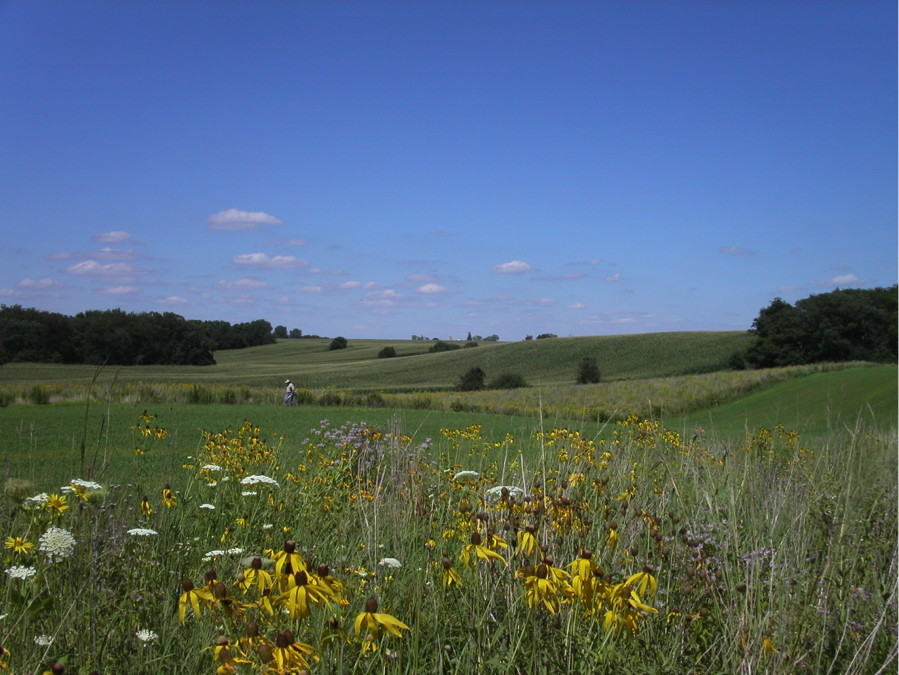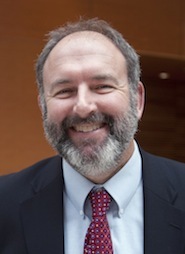Marginal land in demand: researchers explore farmer willingness to grow energy crops

Flower-dotted marginal land in the foreground contrasts sharply with more uniform traditional croplands of corn and alfalfa in the distance.
Photo: Randy Jackson/GLBRC
In their quest to make cellulosic biofuel a viable energy option, many researchers are looking to marginal lands — those unsuitable for growing food — as potential real estate for bioenergy crops. However, few people have asked: how do farmers feel about using their marginal lands for fuel production?
Brad Barham, a UW–Madison professor of agricultural and applied economics and a researcher with the Great Lakes Bioenergy Research Center, took the direct approach. He surveyed Wisconsin farmers.
After analyzing responses from a 2011 questionnaire sent to 300 farmers in southwestern Wisconsin, Barham and his team found that fewer than 30 percent were willing to grow non-edible cellulosic biofuel feedstocks — such as perennial grasses and short-rotation trees — on their marginal lands for a range of prices. The researchers presented the findings at the 2013 meeting of the Agricultural and Applied Economics Association (AAEA) in Washington, D.C. in August.

Brad Barham
“Previous work in the area of marginal lands for bioenergy has been based primarily on the landscape’s suitability, without much research on its economic viability,” says Barham. “How much farmers are willing to change their land-use behavior is what’s in play.”
Despite the minority of positive responses, the researchers found that there were “hotspots” of farmers who showed favorable attitudes toward the use of marginal land for bioenergy. These hotspots might be a window of opportunity for bioenergy researchers, since they indicate areas where feedstocks could be grown more continuously.
“If we want concentrated bioenergy production, that means looking for hotspots where people have favorable attitudes toward crops that can improve the environmental effects associated with energy decisions,” says Barham.

Randy Jackson
Randy Jackson of the UW–Madison Department of Agronomy is also interested in bioenergy hotspots. Jackson, who co-leads GLBRC’s sustainability research area, says that just because lands are too wet, too rocky or too eroded to farm traditionally doesn’t mean they aren’t valuable.
“‘Marginal’ is a relative term,” says Jackson. “When Brad goes out and surveys farmers, he’s looking at more than the biophysical attributes of the soil. He’s also trying to get at the social definition of marginal land — the fact that this land is where the owners like to hunt, for example.”
The goal of GLBRC researchers like Barham and Jackson is to integrate the environmental impacts of different cropping systems with economic and social drivers.
“Ultimately, the questions we’re trying to answer are: if we as a society want certain ecosystem services, how can we manage the landscape to get those services? If we do manage the landscape this way, what are the costs and benefits?” says Jackson.
In addition to providing a versatile starting material for ethanol and other advanced biofuels, cellulosic biofuel feedstocks like perennial grasses do not compete with food crops and require little or no fertilizer or pesticides. Unlike corn, which must be replanted each year, perennials can remain in the soil for more than a decade, conferring ecosystem services like erosion protection and wildlife habitat.
Despite the minority of positive responses, the researchers found that there were “hotspots” of farmers who showed favorable attitudes toward the use of marginal land for bioenergy.
Jackson is also working with UW experts who are developing computer-based simulation tools in projects funded by the GLBRC and a Department of Energy Sun Grant. These tools will help researchers pinpoint where farmer-willingness hotspots overlap with regions that could benefit disproportionately from the ecosystem services that perennial bioenergy feedstocks offer.
“These models will include data layers for geography, crop yield, land use, carbon sequestration, and farmer willingness to participate,” says Jackson. “There could be as many as 40 data layers so that you can see what would happen to each variable if, say, you were to plant the entire landscape with switchgrass.”
Although their research reveals new challenges facing large-scale cellulosic biofuel production, for Barham, it underscores the need for diverse approaches to renewable energy production.
“I think as a country and as researchers, we should always be keeping our options open,” he says. “Hotspots can get the conversation rolling for policy options, because they create the basis of a tangible conversation for people in a place where they’re likely to be receptive to it.”
—Celia Luterbacher


